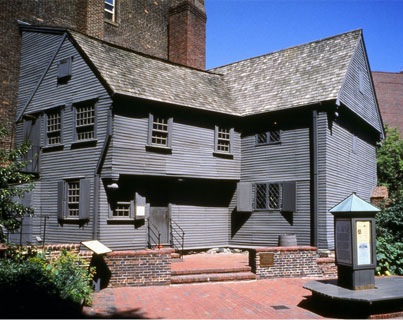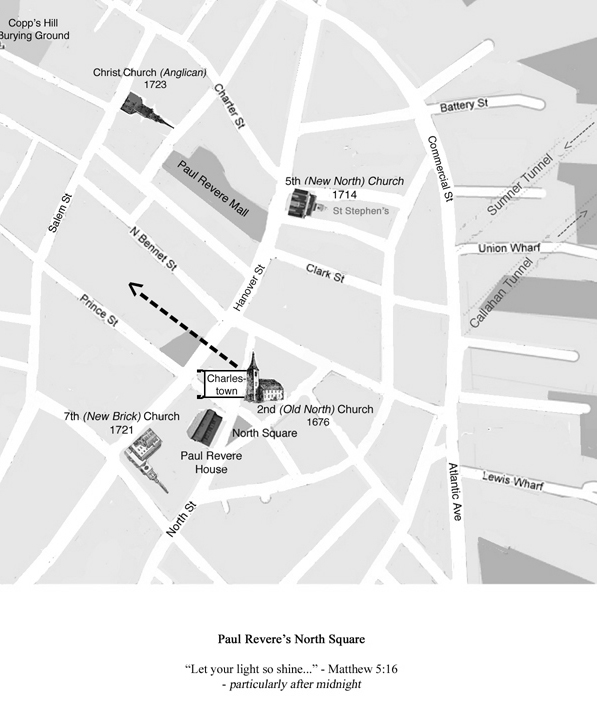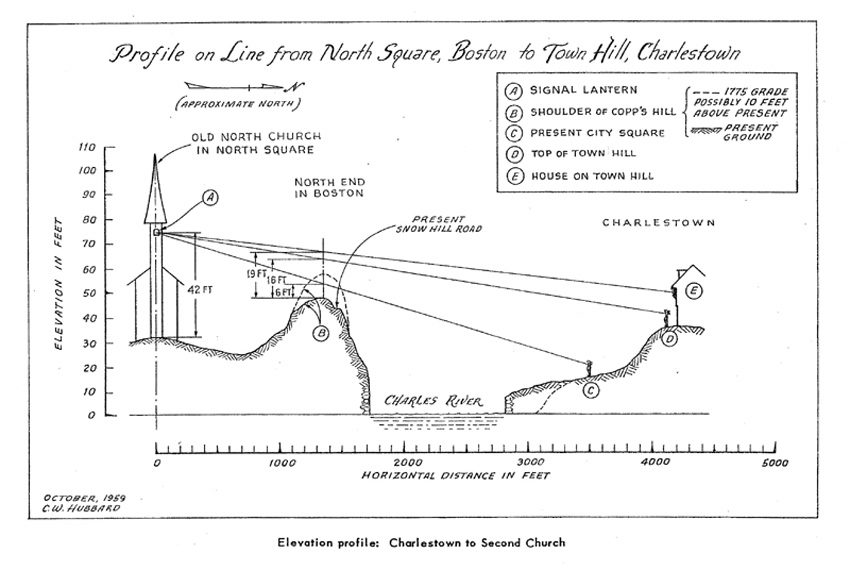The Lanterns Controversy:
A Light Unto the Patriots
 The people of the standing ‘Old North Church’ agree, there are two Old Norths: Christ Church Episcopal ‘Old North,' on Salem Street in the North End of Boston, and the other, the Puritan ‘Old North Church' which stood in North Square. This second Meeting House was built in young Boston to hold the overflowing congregation of the First Church in Boston. The named 'Old North' was consecrated in 1723, while the earlier, true 'Old North Church,' [the Second Church in Boston], signed their covenant seventy-five years earlier, in 1649.
The people of the standing ‘Old North Church’ agree, there are two Old Norths: Christ Church Episcopal ‘Old North,' on Salem Street in the North End of Boston, and the other, the Puritan ‘Old North Church' which stood in North Square. This second Meeting House was built in young Boston to hold the overflowing congregation of the First Church in Boston. The named 'Old North' was consecrated in 1723, while the earlier, true 'Old North Church,' [the Second Church in Boston], signed their covenant seventy-five years earlier, in 1649. Christ Church, at the time of its building, was described as 'the northernmost of the four Anglican Churches' [Church of England] which had been established in Boston after the building of King’s Chapel. The colloquial title, ‘Old North’, came about as each of the first two congregational Churches aged, the First Church in Boston becoming the ‘Old Church,’ while Second became ‘Old North.’ After the fire of 1711, the rebuilt First Church, now sheathed in brick, became known as ‘Old Brick’. The Third Church in Boston is still known today as ‘Old South’.
The controversy as to which ‘Old North’ steeple was the location of the “signal lights” to Revere in Charlestown — giving away the route of the British advance on Concord and Lexington — began after the publication, in 1863, of Henry Wadsworth Longfellow’s The Midnight Ride of Paul Revere: “Listen, my children, and you shall hear Of the midnight ride....”
Some of the historical facts we know are that:
1) The steeple of Old West Church on Cambridge Street had its tower removed by the British for the sole reason that it might be used for beacon signals to the Patriot's ships in Mass Bay.
2) The present Old North Church is the only building Longfellow would have known, for the original ‘Old North’, Second Church, was torn down ‘for firewood’ by the occupying British, after the fateful ‘signal’ and ‘ride’ in the spring of 1775. But on the fateful day of April 18, 1775, the Second (‘Old North’) Church was still standing.
3) At the time of the Revolution, the Salem Street of Christ Church was entirely populated by Tory sympathizers, and British troops were billeted nearby in the houses up and down the street. Their Loyalist minister had returned to England, and the Church building was closed. Yet, a few blocks over in North Square, the Colonists’ Church had a ‘revolutionary preacher’, John Lathrop, and its members constituted ‘a nest of traitors’. Another member, James Caldwell, had been shot to death in the 'lead-up' to the Revolutionary War, the infamous 'Boston Massacre.'

Paul Revere’s house was downhill and diagonally across from Second Church. Revere and his wife Rachel attended the Seventh (‘New Brick’) Church on Hanover Street, ‘even as regularly as the Sabbath came.' They later became members of the Second Church, when the minister, Rev. Ebenezer Pemberton, died. Seventh Church had then voted to take on the name of the older congregation, Second, which, absent a Meeting House, moved in with the new, Seventh congregation.
Henry Wadsworth Longfellow is said to have had a cavalier way of dealing with facts. In the universally popular, but ‘fictional retelling’ of “The Midnight Ride...” the poem brought a ‘lantern controversy’ to the attention of the Boston City Council in the form of a letter from Richard Frothingham, to adjudicate the competing claims of two churches: one, a still standing former Church of England, the other, a non-existant colonialists’ Church building. To settle the ‘naming rights,’ the study needed to conclude from which of the two ‘Old North’ towers the signal lanterns were hung.
In 1876, the Council announced that “an impartial commission [is to be established] to examine all the available evidence.” This commission duly met, and after two years of deliberation, its members decided unanimously in favor of Christ Church. A tablet to that effect was then placed on the church tower in 1878, marking it as the renowned “Old North Church of Paul Revere fame.”
The ‘evidence’ for the commission’s finding is circumstantial at best. The historical documents are absent specific names and lead to no such conclusion. No historical evidence exists that Robert Newman, the sexton of Christ Church, was seen to be present. Paul Revere’s account leaves out names in order to protect the one(s) probably known to him — undoubtedly members of the Patriots’ Church the Second (‘Old North’) Church — as the true signaler(s).
 The Commission had contended that the tower of the 1688 Second Church was too short for a lighted lantern to be seen in Charlestown. But that statement was effectively refuted by John Nicholls Booth in his 1959 book, “Old North Church," providing a convincing report by a city surveyor based on an engineer’s ‘elevation profile.’ Several questions remain unanswered.
The Commission had contended that the tower of the 1688 Second Church was too short for a lighted lantern to be seen in Charlestown. But that statement was effectively refuted by John Nicholls Booth in his 1959 book, “Old North Church," providing a convincing report by a city surveyor based on an engineer’s ‘elevation profile.’ Several questions remain unanswered.From which tower were the lanterns hung? Which tower was safer—not higher; both could easily be seen from Charlestown — for a patriotically inclined Son of Liberty to show the lanterns which called the Colonists to war, a war which changed the heart and soul of an aspiring republic? Which answer is plain truth, and which the traditional poetic story? Do John F Kennedy's words not ring true: “The enemy of truth is not the lie, but the myth?”

Second ('Old North') Church. Torn down by the British.
